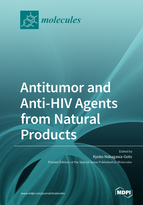Antitumor and Anti-HIV Agents from Natural Products
A special issue of Molecules (ISSN 1420-3049). This special issue belongs to the section "Natural Products Chemistry".
Deadline for manuscript submissions: closed (31 December 2019) | Viewed by 79243
Special Issue Editor
2. Adjunct Associate Professor, Eshelman School of Pharmacy, The University of North Carolina at Chapel Hill, Chapel Hil, NC, USA
Interests: medicinal chemistry; drug discovery; natural products; antitumor; anti-virus; synthesis of bioactive compounds; chemical biology
Special Issues, Collections and Topics in MDPI journals
Special Issue Information
Dear Colleagues,
Cancer is the second leading cause of death worldwide and was accountable for an estimated 9.6 million deaths in 2018. Nowadays, about 1 in 6 deaths in the world is due to cancer. Another major global public health issue is HIV. Over 70 million people have been infected with the HIV virus and about 35 million people have died of HIV-related illness, since the start of the epidemic. We have been fighting against these two serious diseases by finding successful treatments. The discovery of effective drugs is important for fighting cancer and HIV.
Natural products, which are secondary metabolites produced by various living organisms, have been playing a principal role in drug discovery and developments because of the structural and biological diversity. Many clinically-used drugs have come from natural products, for an example, more than 60% of anticancer drugs currently in clinical use are derived from natural sources.
This Special Issue aims to collect the original research and review articles focusing on notable and recent contributions to the discovery and development of novel anticancer and anti-HIV drug candidates from natural sources. Up-to-date knowledge from various research fields is welcome. This could be of great interest for scientists working in different research areas, such as natural product chemistry, including isolation and structural elucidation; phytochemistry; medicinal chemistry, including chemically modified natural compounds with improved biological activity; pharmacology; molecular biology; mechanisms of action study using natural products or related compounds; pharmacognosy etc. Biological studies of natural extracts without an appropriate chemical characterization may not be considered.
Prof. Dr. Kyoko Nakagawa-Goto
Guest Editor
Manuscript Submission Information
Manuscripts should be submitted online at www.mdpi.com by registering and logging in to this website. Once you are registered, click here to go to the submission form. Manuscripts can be submitted until the deadline. All submissions that pass pre-check are peer-reviewed. Accepted papers will be published continuously in the journal (as soon as accepted) and will be listed together on the special issue website. Research articles, review articles as well as short communications are invited. For planned papers, a title and short abstract (about 100 words) can be sent to the Editorial Office for announcement on this website.
Submitted manuscripts should not have been published previously, nor be under consideration for publication elsewhere (except conference proceedings papers). All manuscripts are thoroughly refereed through a single-blind peer-review process. A guide for authors and other relevant information for submission of manuscripts is available on the Instructions for Authors page. Molecules is an international peer-reviewed open access semimonthly journal published by MDPI.
Please visit the Instructions for Authors page before submitting a manuscript. The Article Processing Charge (APC) for publication in this open access journal is 2700 CHF (Swiss Francs). Submitted papers should be well formatted and use good English. Authors may use MDPI's English editing service prior to publication or during author revisions.
Keywords
- Natural products
- Natural product derivatives
- Synthetic derivatives inspired by natural scaffolds
- Phytochemistry
- Pharmacognosy
- Structure elucidation
- Isolation and purification
- Drug discovery and development
- Antitumor/antiproliferative activity
- Anti-HIV
- Chemosensitizer
- Cancer prevention
- Structure–activity relationship
- Mechanisms of action study







